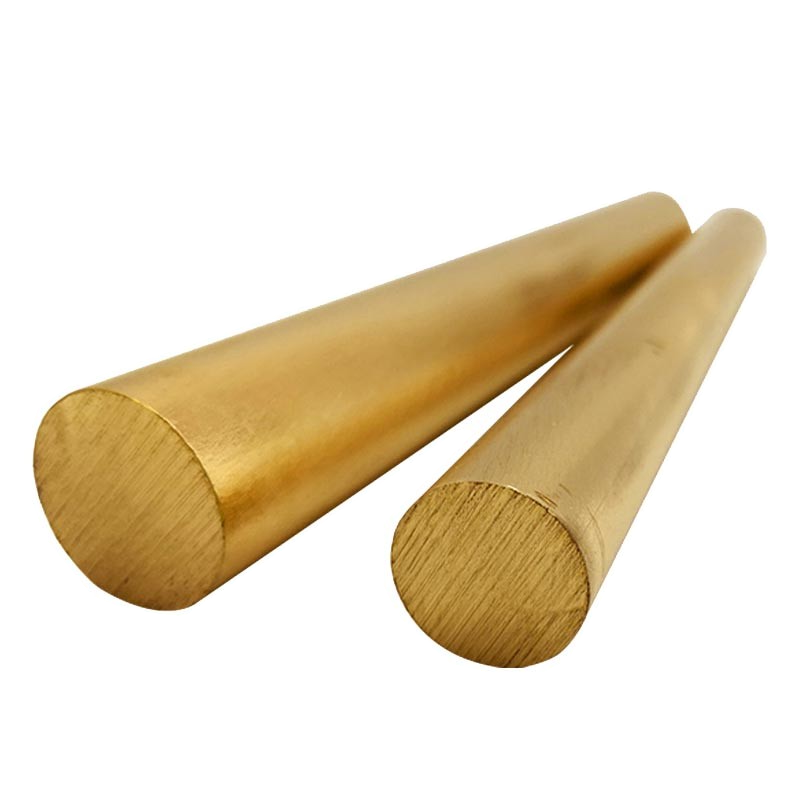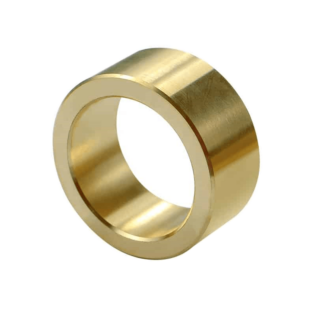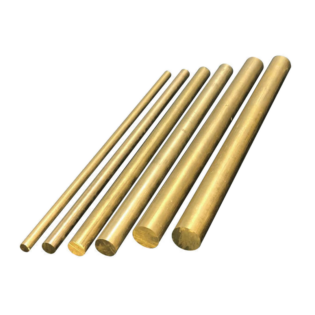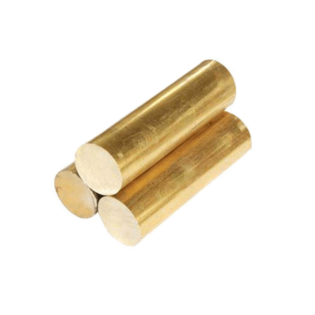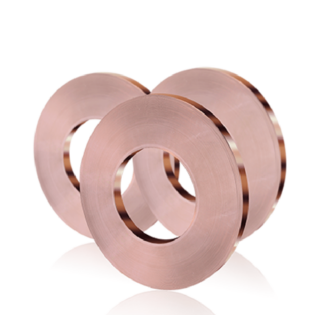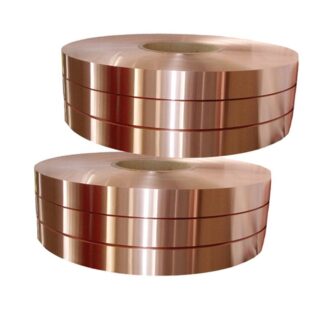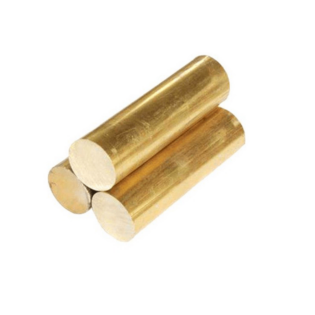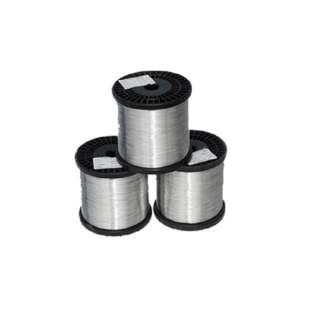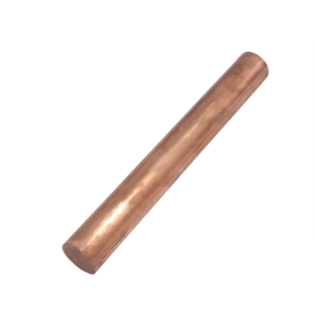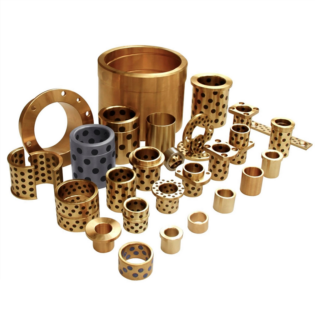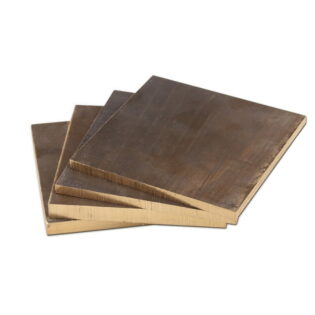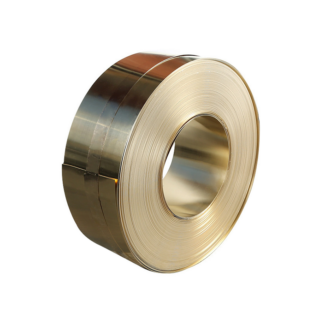Description C36000
Le laiton de coupe libre C36000 est un alliage de cuivre-zinc à haute performance conçu spécifiquement pour une machinabilité supérieure. Contenant 2,5 à 3,0% de plomb pour des caractéristiques de coupe améliorées, cet alliage offre un contrôle exceptionnel des puces, une durée de vie de l'outil prolongé et des finitions de surface supérieures. Avec une note de machinabilité de 100% (norme de l'industrie), C36000 permet une production à grande vitesse de composants de précision tout en maintenant d'excellentes propriétés mécaniques et une bonne résistance à la corrosion.
Spécifications rapides
C36000 Free Cuting Lrass - Introduction du produit technique
Aperçu du produit
C36000 Free Cuting Lrass, également connu sous le nom d'alliage 360 ou laiton d'usinage libre, est un alliage de cuivre-zinc spécialement conçu pour une machinabilité exceptionnelle. Cet alliage intègre des quantités contrôlées de plomb à améliorer considérablement les caractéristiques de coupe, ce qui en fait la norme de l'industrie pour les opérations d'usinage à grande vitesse et la fabrication de composants de précision.
Caractéristiques techniques clés
| Caractéristique | spécification | Avantage technique |
|---|---|---|
| Cote d'usinabilité | 100% (norme de l'industrie) | Vitesses de coupe les plus rapides, meilleur contrôle des puces |
| Contenu de plomb | 2,5-3,0% | Rupture optimale des puces et lubrification des outils |
| Capacité de finition de surface | RA 0,4-0,8 μm | Finition secondaire minimale requise |
| Conductivité thermique | 115 w / m · k | Excellente dissipation de la chaleur pendant l'usinage |
| Conductivité électrique | 26% IACS | Convient aux applications électriques |
| Résistance à la corrosion | Bon dans les conditions atmosphériques | Durabilité à long terme dans la plupart des environnements |
Composition chimique
Composition chimique standard (ASTM B16)
| Élément | Contenu (%) | Fonction | Analyse typique |
|---|---|---|---|
| Cuivre | 60.0-63.0 | Métal de base pour la force et la conductivité | 61,5 |
| Zinc (Zn) | Reste | Amélioration de la force et optimisation des coûts | 35,5 |
| Plomb (Pb) | 2.5-3.0 | Amélioration de la machinabilité et contrôle des puces | 2.8 |
| Fer (Fe) | ≤0,35 | Impureté contrôlée | 0.15 |
| Nickel (Ni) | 0,5 | Élément d'alliage mineur | 0.25 |
| Aluminium (Al) | est un acier résistant à l'usure avec une dureté moyenne de | Désoxydant | 0.02 |
| Autres éléments | ≤0,5 total | Impuretés contrôlées | – |
Comparaison de composition avec des alliages connexes
| Alliage | Cu (%) | Zn (%) | PB (%) | Caractéristique primaire |
|---|---|---|---|---|
| C36000 | 60.0-63.0 | Rém | 2.5-3.0 | Excellente machinabilité |
| C26000 | 68.5-71.5 | Rém | – | Ductilité élevée |
| C38500 | 56.0-59.0 | Rém | 2,5-3,5 | Applications architecturales |
| C46400 | 59.0-62.0 | Rém | – | Laiton naval |
| C35300 | 60.0-63.0 | Rém | 1.5-2.5 | Contenu de plomb moyen |
Propriétés mécaniques
Propriétés mécaniques par état de tempérament
| Désignation de tempérament | Résistance à la traction (MPa) | Limite d'élasticité (MPa) | Allongement (%) | Dureté (RB) | Réduction de la superficie (%) |
|---|---|---|---|---|---|
| O61 (recuit) | 338-380 | 124-140 | 45-53 | 50-60 | 55-65 |
| H01 (1/4 dur) | 370-415 | 140-310 | 25-35 | 62-75 | 45-55 |
| H02 (1/2 dur) | 415-450 | 165-345 | 20-30 | 75-85 | 35-45 |
| H04 (complet dur) | 450-485 | 180-380 | 15-25 | 80-90 | 25-35 |
Propriétés de la fatigue et de l'impact
| Propriété | Valeur | Condition de test | Standard |
|---|---|---|---|
| Résistance à la fatigue | 140-160 MPA | 10⁸ cycles, faisceau rotatif | ASTM D7791 |
| Résistance aux chocs | 35-45 J | Charpy en V, température ambiante | ASTM E23 |
| Ténacité de fracture | 45-55 MPa√m | Conditions de tension plane | ASTM E399 |
| Limite d'endurance | 130-150 MPa | Chargement entièrement inversé | ASTM D7791 |
Propriétés physiques
Propriétés thermiques et électriques
| Propriété | Valeur | Unité | Température (°C) | Méthode d'essai |
|---|---|---|---|---|
| Densité | 8.49 | g/cm³ | 20 | ASTM B311 |
| Point de fusion (solide) | 885 | °C | – | Analyse DSC |
| Point de fusion (liquide) | 900 | °C | – | Analyse DSC |
| Conductivité thermique | 115 | W/m·K | 20 | ASTM E1461 |
| Conductivité thermique | 125 | W/m·K | 100 | ASTM E1461 |
| Conductivité électrique | 26 | % IACS | 20 | ASTM B193 |
| Résistivité électrique | 0.066 | ·m | 20 | ASTM B193 |
Extension thermique et propriétés du module
| Propriété | Valeur | Unité | Plage de température | Standard |
|---|---|---|---|---|
| Coefficient d'expansion linéaire | 20,5 | μm / m · ° C | 20-100°C | ASTM E831 |
| Coefficient d'expansion linéaire | 21,0 | μm / m · ° C | 20-200°C | ASTM E831 |
| Propriétés mécaniques de l'acier à outils AISI HSS M2 | 97 | GPa | 20°C | ASTM E111 |
| Module de cisaillement | 37 | GPa | 20°C | ASTM E143 |
| Coefficient de Poisson | 0.34 | – | 20°C | ASTM E132 |
| La capacité thermique spécifique | 377 | J / kg · k | 20°C | ASTM E1269 |
Caractéristiques de machinabilité
Paramètres d'usinage optimaux
| Opération | Vitesse (m / min) | Taux d'alimentation (mm / révérend) | Profondeur de coupe (mm) | Géométrie de l'outil | Finition de surface (RA μM) |
|---|---|---|---|---|---|
| Tournant - ébauche | 150-300 | 0.25-0.50 | 2.0-5.0 | CNMG, DNMG | 1.6-3.2 |
| Tournant - finir | 200-400 | 0.05-0.20 | 0.5-2.0 | CNMG, VCMT | 0.4-0.8 |
| Moulin à face | 100-200 | 0.10-0.30 | 1.0-3.0 | Insert du moulin à face | 0.8-1.6 |
| Broyage final | 80-150 | 0.08-0.20 | 1.0-2.0 | Moulin à extrémité en carbure | 0.8-1.6 |
| Forage (HSS) | 30-60 | 0.10-0.30 | – | Angle de point de 118 ° | 1.6-3.2 |
| Forage (carbure) | 60-120 | 0.15-0.35 | – | Angle de point de 130 ° | 1.6-3.2 |
| Alésage | 15-30 | 0.20-0.50 | 0.1-0.3 | Flûte droite | 0.4-0.8 |
| Filetage | 20-40 | Dépendant de la hauteur | – | Outil de filetage à 60 ° | 1.6-3.2 |
Performance de vie et d'usinage de l'outil
| Matériau à outils de coupe | Vie à l'outil relatif | Application recommandée | Plage de vitesse de coupe |
|---|---|---|---|
| Acier à grande vitesse (HSS) | 100% (ligne de base) | Usinage général, forage, tapotement | 30-100 m / moi |
| Carbure non enduit | 200-300% | Tournant à grande vitesse, fraisage | 100-300 m / moi |
| Carbure enduit d'étain | 300-400% | Applications de durée de vie des outils étendus | 150-400 m / moi |
| Tialn enduit de carbure | 350-450% | Finition à grande vitesse | 200-500 m / moi |
| CBN (nitrure de bore cubique) | 500-800% | Usinage ultra-haut | 300-800 m / moi |
Formation et contrôle des puces
| Opération d'usinage | Type de puce | Cote de commande de puce | Pause recommandée | Modèle d'usure d'outil |
|---|---|---|---|---|
| Tournant | Chips courts et cassés | Excellent | Géométrie du disjoncteur de puce | Usure de flanc uniforme |
| Fraisage | Petits segments | Très bien | Angle de râteau positif | Tarif d'angle |
| Forage | Croustilles de ruban | Bon | Géométrie ponctuelle appropriée | Usure de flanc sur les marges |
| Filetage | Croustilles fines | Excellent | Tranchant pointu | Tenue minimale |
Applications et utilisations
Catégories d'application principale
| Secteur de l'industrie | Exemples de composants | Exigences de performance | Avantages matériels |
|---|---|---|---|
| Automobile | Raccords de système de carburant, raccords de ligne de frein, bornes électriques | Précision, résistance à la pression, résistance à la corrosion | Usinage facile, tolérances serrées réalisables |
| Électrique/Électronique | Connecteurs, bornes, composants de l'interrupteur, vis de mise à la terre | Conductivité électrique, précision, fiabilité | Bonne conductivité, excellente machinabilité |
| Plomberie / CVC | Raccords de tuyaux, composants de vanne, raccords de compression | Évaluation de la pression, résistance à la corrosion, fiabilité | Propriétés de scellement rentables et économiques |
| Machinerie industrielle | Vitesses, bagues, roulements, attaches mécaniques | Résistance à l'usure, stabilité dimensionnelle, force | Contenu de plomb auto-lubrifiant |
| Matériel marin | Attaches non critiques, matériel décoratif | Résistance à la corrosion dans les environnements d'eau douce | Bonne résistance à la corrosion atmosphérique |
| Instruments de musique | Assemblages de soupape, diapositives, composants mécaniques | Fonctionnement lisse, précision, durabilité | Excellente capacité de finition de surface |
Applications de composants spécifiques
| Type de composant | Gamme de taille typique | Exigences critiques | Processus de fabrication |
|---|---|---|---|
| Raccords filetés NPT | Taille de tuyau 1/8 "à 4" | Précision du thread, scellage de pression | Tournure CNC, coupe de fil |
| Bornes électriques | 2 mm à 50 mm de largeur | Conductivité, rétention de sertissage | Estampage, usinage CNC |
| Corps de valve | Taille du port 1/4 "à 6" | Évaluation de pression, fuite | Usinage CNC, forage |
| Composants de vitesse | 10 mm à 300 mm de diamètre | Précision des dents, résistance à l'usure | Couper des engrenages, traitement thermique |
| Bagues / roulements | Alésage de 5 mm à 150 mm | Précision dimensionnelle, finition de surface | Tourner, ennuyer, aléir |
| Connecteurs personnalisés | Spécifique à l'application | Propriétés électriques, tolérances d'ajustement | Usinage CNC multi-axe |
Performance dans les environnements de service
| Environnement | Résistance à la corrosion | Limite de température | Cote d'adéquation | Limites |
|---|---|---|---|---|
| Atmosphérique intérieur | Excellent | -40 ° C à + 200 ° C | Excellent | Aucun significatif |
| Atmosphérique extérieur | Bon | -40 ° C à + 150 ° C | Bon | Entretien régulier recommandé |
| Eau douce | Bon | 0° C à + 80 ° C | Bon | Évitez les conditions stagnantes |
| Marine (eau de mer) | Ouvrage écroui par laminage puis stabilisé par traitement thermique à basse température jusqu'au quart de dur | N / A | Non recommandé | Utilisez plutôt des cuivres navals |
| Produits chimiques industriels | Variable | Dépend du produit chimique | Évaluation au cas par cas | Test de compatibilité chimique requis |
| Haute température | Bon | Jusqu'à 200 ° C continu | Bon | Résistance à l'oxydation acceptable |
Formulaires de produit disponibles
Formes et dimensions de produits standard
| Formulaire de produit | Gamme de tailles | Longueurs standards | Classe de tolérance | État des surfaces |
|---|---|---|---|---|
| Barre ronde | 3 mm - 350 mm de diamètre | 1m, 2m, 3m, 4m, 6m | H9, H11 (ISO 286) | Terrain brillant et sans centre |
| Barre | 5 mm - 150 mm de travers les appartements | 1m, 2m, 3m, 4m | ± 0,13 mm | Brillant |
| Barre carrée | 5 mm - 100 mm carré | 1m, 2m, 3m, 4m | ± 0,13 mm | Brillant |
| Barre rectangulaire | 3-60 mm × 10-200 mm | 1m, 2m, 3m, 4m | ± 0,15 mm | Dessin à froid, finition du moulin |
| Barre creuse (tube) | 10-300 mm OD, mur 2-250 mm | 1m, 2m, 3m, 6m | ± 0,20 mm | Comme dessiné, brillant |
| Câble | 0.5 mm - 15 mm de diamètre | Bobines ou longueurs de coupe | ± 0,05 mm | Brillant |
Tolérances dimensionnelles et finition de surface
| Diamètre (mm) | Tolérance standard (mm) | Tolérance à la précision (mm) | Rugosité de surface (ra μm) | Tolérance à la rectitude |
|---|---|---|---|---|
| 3-6 | ± 0,05 | ±0,02 | 0.4-0.8 | 0.5 mm / m |
| 6-10 | ± 0,08 | ± 0,03 | 0.4-0.8 | 0.5 mm / m |
| 10-18 | ± 0,10 | ± 0,04 | 0.6-1.0 | 0.3 mm / m |
| 18-30 | ± 0,13 | ± 0,05 | 0.8-1.2 | 0.3 mm / m |
| 30-50 | ± 0,16 | ± 0,06 | 0.8-1.6 | 0.2 mm / m |
| 50-80 | ± 0,19 | ± 0,08 | 1.0-1.6 | 0.2 mm / m |
| 80-120 | ± 0,22 | ± 0,10 | 1.2-2.0 | 0.15 mm / m |
| 120-200 | ± 0,25 | ± 0,12 | 1.6-2.5 | 0.15 mm / m |
Normes et spécifications
Conformité des normes internationales
| Standard | Désignation complète | Portée géographique | Couverture de spécification |
|---|---|---|---|
| ASTM B16 / B16M | Tie en laiton, barre et formes en laiton gratuite | Amérique du Nord | Composition chimique, propriétés mécaniques, dimensions |
| En 12164 | Alliages de cuivre et de cuivre - tige à des fins d'usinage | L'Europe | Exigences de fabrication, tolérances, tests |
| HE H3250 | Tiges et barres en alliage en cuivre et en cuivre | Japon | Composition chimique, propriétés mécaniques, inspection |
| ISO 426-2 | Alliages en cuivre-zinc forgé - composition chimique et formes | International | Système de désignation, limites chimiques |
| BS EN 12163 | Alliages de cuivre et de cuivre - tige à des fins générales | Royaume-Uni | Spécifications générales, exigences de qualité |
| À partir de 17660 | Alliages de cuivre-zinc - composition chimique et propriétés mécaniques | Allemagne | Spécifications du matériau, méthodes de test |
Limites de composition chimique par standard
| Standard | Cu (%) | Zn (%) | PB (%) | FE (%) | Autres éléments |
|---|---|---|---|---|---|
| ASTM B16 | 60.0-63.0 | Reste | 2.5-3.0 | ≤0,35 | Ni ≤0,5%, d'autres ≤ 0,5% total total |
| En 12164 | 60.0-63.0 | Reste | 2.5-3.0 | ≤0,35 | Ni ≤0,5%, à ≤0,05% |
| HE H3250 | 60.0-63.0 | Reste | 2.5-3.0 | ≤0,35 | Similaire à ASTM |
| ISO 426-2 | 60.0-63.0 | Reste | 2.5-3.0 | ≤0,35 | Harmonisé avec en |
Exigences de propriété mécanique par standard
| Standard | Résistance à la traction (MPa) | Limite d'élasticité (MPa) | Allongement (%) | Dureté |
|---|---|---|---|---|
| ASTM B16 (O61) | 338-380 | 124 min | 15 min | 50-70 RB |
| ASTM B16 (H02) | 415-485 | 275 minutes | 8 min | 75-90 RB |
| EN 12164 (M) | 340-430 | 140 min | 15 min | 60-85 hb |
| JIS H3250 (O) | 340-390 | 130 min | 15 min | 60-80 Hb |
Traitement thermique et traitement
Spécifications de traitement thermique
| Type de traitement | Plage de températures (° C) | Temps à la température | Méthode de refroidissement | Propriétés résultant |
|---|---|---|---|---|
| Recuit (O61) | 425-650 | 1 à 4 heures | À l'air refroidi | Ductilité molle et maximale |
| Soulagement du stress | 200-300 | 1-2 heures | À l'air refroidi | Stress interne réduit |
| Traitement de solution | 700-750 | 1 heure | Quench | Structure homogène |
| Recuit de processus | 300-400 | 30-60 minutes | À l'air refroidi | Adoucissement partiel |
Caractéristiques de traitement
| Traiter | Cote de formabilité | Exigences de température | Considérations spéciales |
|---|---|---|---|
| Travail à froid | Bon | Température ambiante | Un durcissement des travaux se produit, un recuit périodique peut être nécessaire |
| Travail à chaud | Excellent | 600-750 ° C | Meilleure formabilité, évitez la surchauffe |
| Soudage | Équitable | Divers | Présentation de la vaporisation des plombs, ventilation requise |
| Brasage | Bon | 600-850 ° C | Compatible avec la plupart des alliages de brasage |
| Soudure | Excellent | 180-250 ° C | Facile à souder, bonne résistance aux articulations |
Contrôle et test de qualité
Méthodes de test standard
| Propriété | Méthode d'essai | Échantillon | Fréquence | Critères d'acceptation |
|---|---|---|---|---|
| Composition chimique | Spectroscopie XRF (ASTM E1086) | 3 morceaux par chaleur | Chaque chaleur | Dans les limites de spécification |
| Propriétés de traction | Test de traction (ASTM E8) | 2 spécimens par lot | Par lot de production | Répondre aux exigences standard |
| Dureté | Rockwell B (ASTM E18) | 3 lectures par pièce | Échantillonnage statistique | Dans la plage spécifiée |
| Précision dimensionnelle | Coordonnées à la mesure (ASTM E1) | 100% ou échantillonnage | Continu | Dans la tolérance |
| Qualité de surface | Inspection visuelle (ASTM B250) | 100% | Continu | Pas de défauts |
| Microstructure | Métallographie (ASTM E3) | 1 par production | Hebdomadaire | Structure uniforme α + β |
Classification des défauts et limites
| Type de défaut | Classe A (critique) | Classe B (Major) | Classe C (mineur) | Méthode de détection |
|---|---|---|---|---|
| Composition chimique | Hors spécification | Près des limites | – | Analyse spectroscopique |
| Variation dimensionnelle | >2× tolerance | >1.5× tolerance | >tolerance | Mesure dimensionnelle |
| Défauts de surface | Fissures, rayures profondes | Rayures peu profondes | Marques légères | Inspection visuelle |
| Déviation de dureté | >±10 points | >±5 points | Dans un dans 5 points | Test de dureté |
| Défauts internes | Vides, inclusions | Porosité mineure | – | Tests par ultrasons |
Considérations environnementales et de sécurité
Informations sur la sécurité des matériaux
| Catégorie de danger | Niveau de risque | Préoccupation | Mesures de sécurité |
|---|---|---|---|
| Contenu de plomb | Modéré | Ingestion, inhalation de poussière / fumées | Utilisez la ventilation, évitez l'usinage de l'inhalation de la poussière |
| Opérations d'usinage | Faible | Génération de poussière métallique | Pratiques d'atelier d'usinage standard |
| Soudage / brasage | Modéré | Génération de fumées de plomb | Ventilation adéquate, protection respiratoire |
| Risque | Très bas | Métal non combustible | Précautions d'incendie standard |
| Environnement | Modéré | Le contenu du plomb nécessite une élimination appropriée | Suivez les réglementations locales pour les déchets métalliques |
Recyclage et élimination
| Aspect | Exigence | Méthode de conformité |
|---|---|---|
| Identification des matériaux | Déclaration de contenu en plomb | Documentation de certification matérielle |
| Ségrégation de ferraille | Collection de laits de plomb séparé | Conteneurs de ferraille désignés |
| Processus de recyclage | Recyclage en laiton spécialisé | Recycleurs en métal certifié |
| Élimination des déchets | Classification des déchets dangereux | Services d'élimination des déchets agréés |
| Documentation | Chaîne de dossiers de garde | Systèmes de suivi des matériaux |
Cette spécification technique fournit des informations complètes sur les cuivres de coupe gratuits C36000 pour les applications d'ingénierie et de fabrication.

